Strategic Management Accounting Report: PAS Case Study Analysis
VerifiedAdded on 2023/03/20
|14
|3126
|61
Report
AI Summary
This report analyzes the performance-related pay system implemented by Petrol Automotive Services (PAS), a manufacturer of small engines. The report delves into the application of Herzberg's Two-Factor Theory and expectancy theory to understand employee motivation within the context of PAS's manufacturing plant. It examines the features of the performance-related pay system, evaluating the appropriateness of three performance measures—cycle time, material usage, and output product—for assessing performance and awarding bonuses. The analysis highlights the dependencies between teams and their impact on performance. Furthermore, the report suggests improvements to the system, including adjustments to performance measures, the implementation of individual incentive plans, and better management of employee complaints. The report concludes with a discussion of alternative incentive schemes and non-financial performance measures, offering a comprehensive overview of strategic management accounting principles in a real-world business scenario.
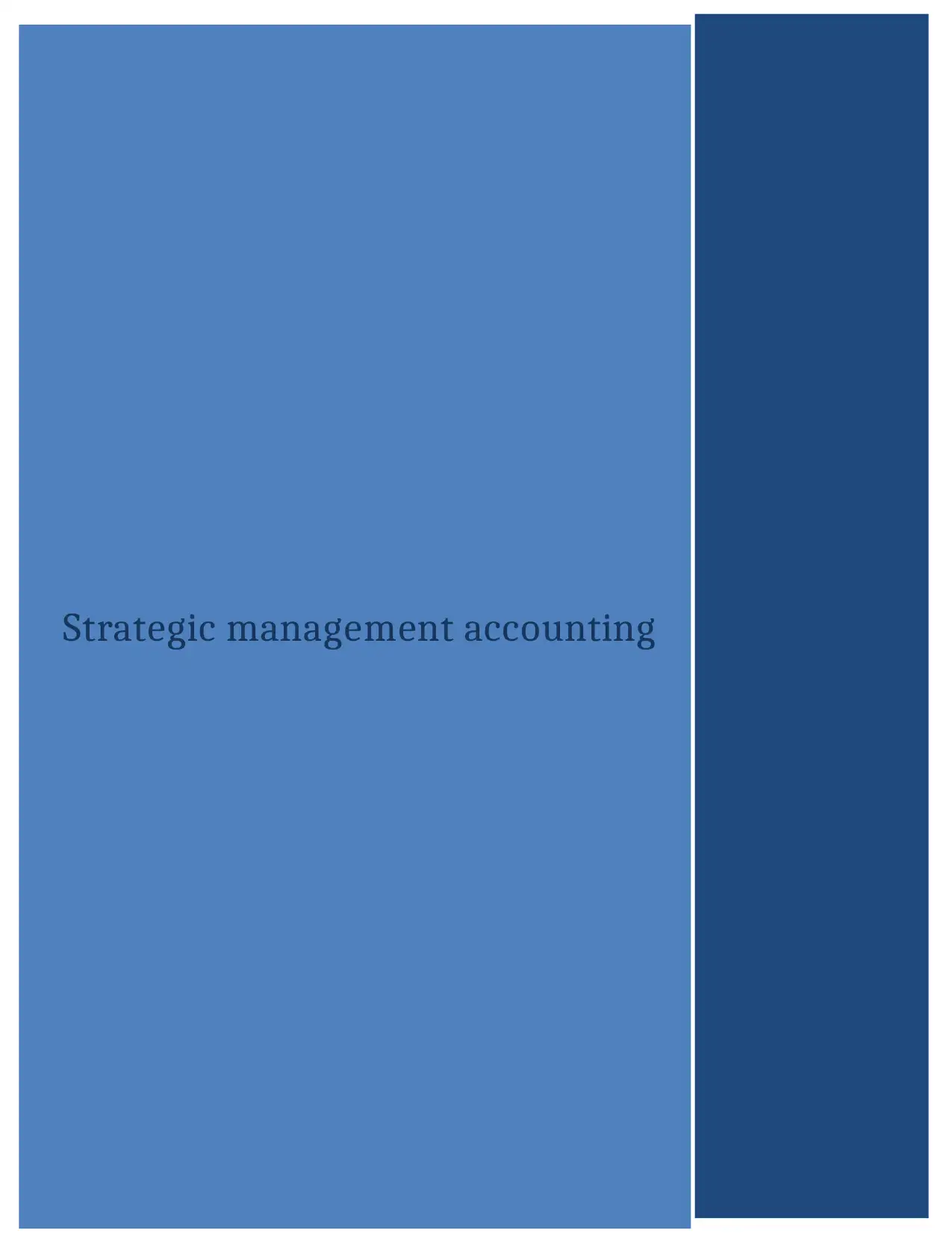
Strategic management accounting
Paraphrase This Document
Need a fresh take? Get an instant paraphrase of this document with our AI Paraphraser
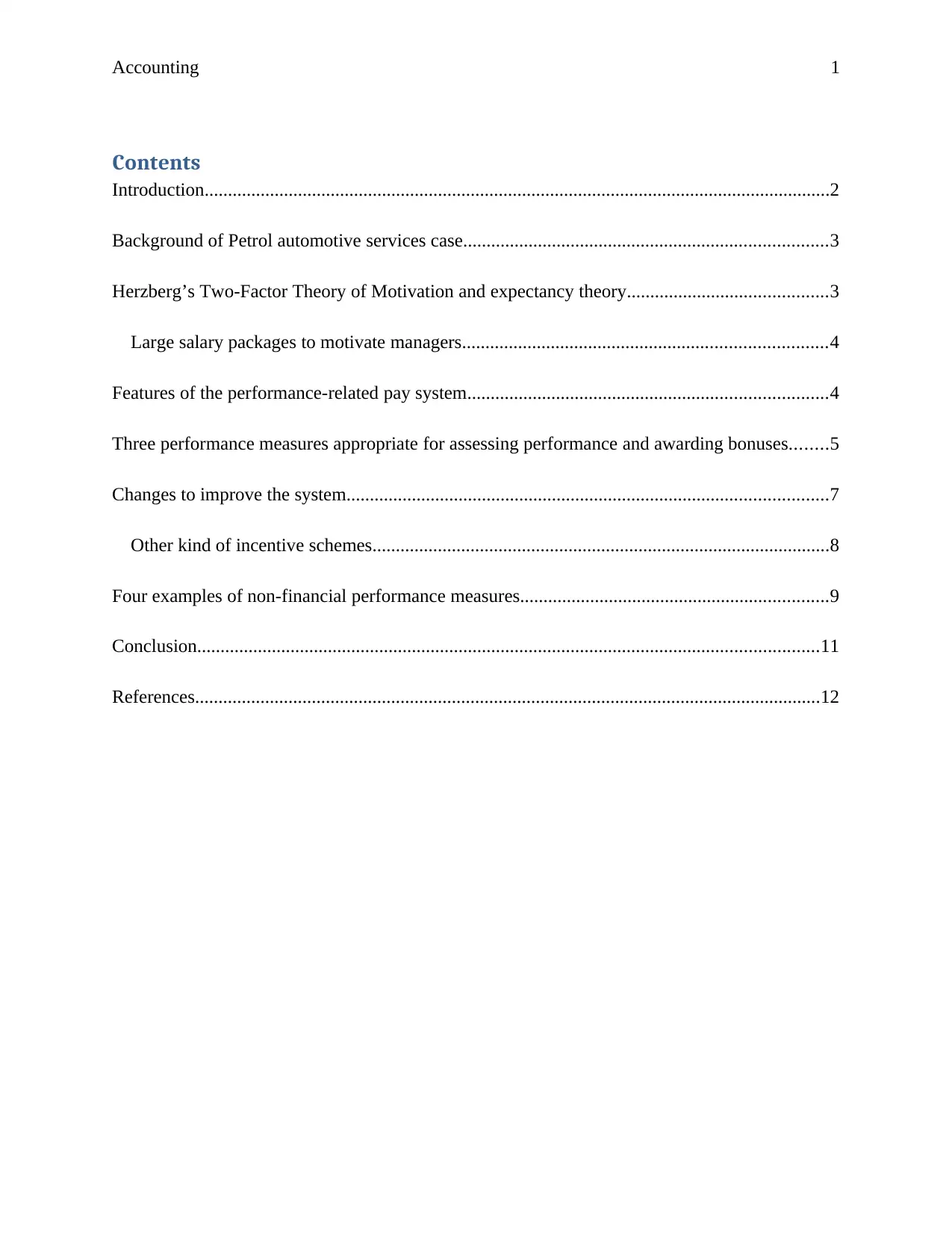
Accounting 1
Contents
Introduction......................................................................................................................................2
Background of Petrol automotive services case..............................................................................3
Herzberg’s Two-Factor Theory of Motivation and expectancy theory...........................................3
Large salary packages to motivate managers..............................................................................4
Features of the performance-related pay system.............................................................................4
Three performance measures appropriate for assessing performance and awarding bonuses........5
Changes to improve the system.......................................................................................................7
Other kind of incentive schemes..................................................................................................8
Four examples of non-financial performance measures..................................................................9
Conclusion.....................................................................................................................................11
References......................................................................................................................................12
Contents
Introduction......................................................................................................................................2
Background of Petrol automotive services case..............................................................................3
Herzberg’s Two-Factor Theory of Motivation and expectancy theory...........................................3
Large salary packages to motivate managers..............................................................................4
Features of the performance-related pay system.............................................................................4
Three performance measures appropriate for assessing performance and awarding bonuses........5
Changes to improve the system.......................................................................................................7
Other kind of incentive schemes..................................................................................................8
Four examples of non-financial performance measures..................................................................9
Conclusion.....................................................................................................................................11
References......................................................................................................................................12
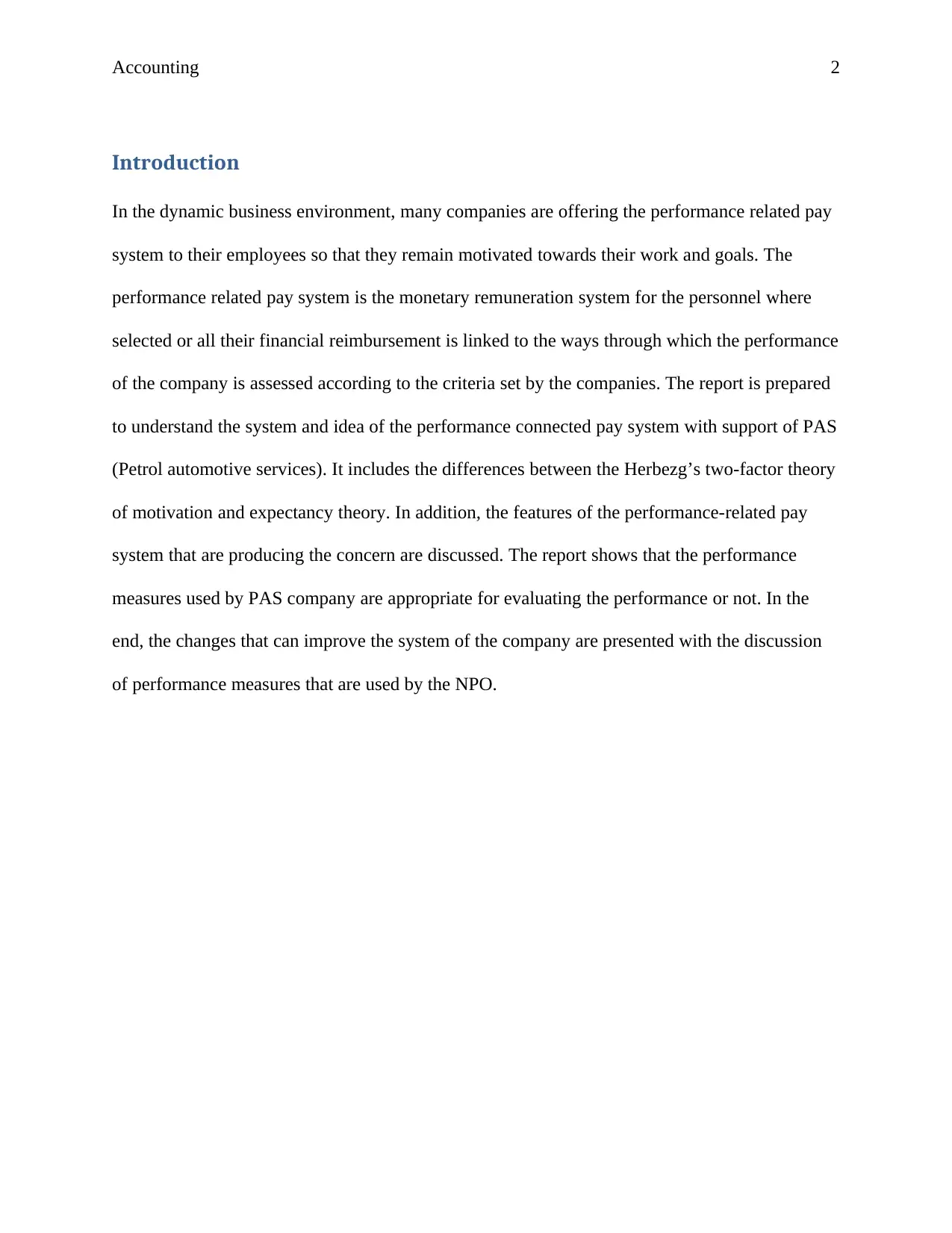
Accounting 2
Introduction
In the dynamic business environment, many companies are offering the performance related pay
system to their employees so that they remain motivated towards their work and goals. The
performance related pay system is the monetary remuneration system for the personnel where
selected or all their financial reimbursement is linked to the ways through which the performance
of the company is assessed according to the criteria set by the companies. The report is prepared
to understand the system and idea of the performance connected pay system with support of PAS
(Petrol automotive services). It includes the differences between the Herbezg’s two-factor theory
of motivation and expectancy theory. In addition, the features of the performance-related pay
system that are producing the concern are discussed. The report shows that the performance
measures used by PAS company are appropriate for evaluating the performance or not. In the
end, the changes that can improve the system of the company are presented with the discussion
of performance measures that are used by the NPO.
Introduction
In the dynamic business environment, many companies are offering the performance related pay
system to their employees so that they remain motivated towards their work and goals. The
performance related pay system is the monetary remuneration system for the personnel where
selected or all their financial reimbursement is linked to the ways through which the performance
of the company is assessed according to the criteria set by the companies. The report is prepared
to understand the system and idea of the performance connected pay system with support of PAS
(Petrol automotive services). It includes the differences between the Herbezg’s two-factor theory
of motivation and expectancy theory. In addition, the features of the performance-related pay
system that are producing the concern are discussed. The report shows that the performance
measures used by PAS company are appropriate for evaluating the performance or not. In the
end, the changes that can improve the system of the company are presented with the discussion
of performance measures that are used by the NPO.
⊘ This is a preview!⊘
Do you want full access?
Subscribe today to unlock all pages.

Trusted by 1+ million students worldwide
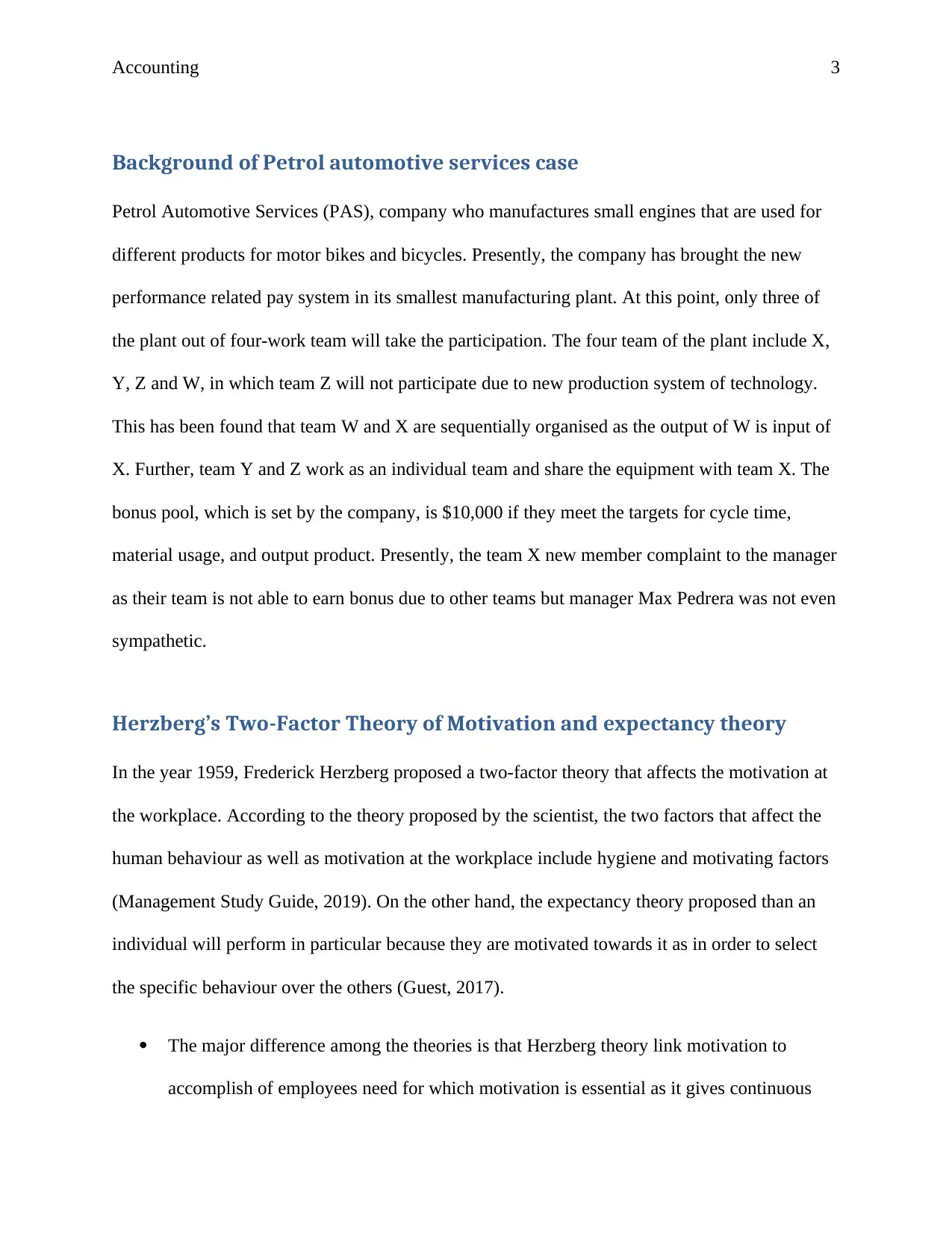
Accounting 3
Background of Petrol automotive services case
Petrol Automotive Services (PAS), company who manufactures small engines that are used for
different products for motor bikes and bicycles. Presently, the company has brought the new
performance related pay system in its smallest manufacturing plant. At this point, only three of
the plant out of four-work team will take the participation. The four team of the plant include X,
Y, Z and W, in which team Z will not participate due to new production system of technology.
This has been found that team W and X are sequentially organised as the output of W is input of
X. Further, team Y and Z work as an individual team and share the equipment with team X. The
bonus pool, which is set by the company, is $10,000 if they meet the targets for cycle time,
material usage, and output product. Presently, the team X new member complaint to the manager
as their team is not able to earn bonus due to other teams but manager Max Pedrera was not even
sympathetic.
Herzberg’s Two-Factor Theory of Motivation and expectancy theory
In the year 1959, Frederick Herzberg proposed a two-factor theory that affects the motivation at
the workplace. According to the theory proposed by the scientist, the two factors that affect the
human behaviour as well as motivation at the workplace include hygiene and motivating factors
(Management Study Guide, 2019). On the other hand, the expectancy theory proposed than an
individual will perform in particular because they are motivated towards it as in order to select
the specific behaviour over the others (Guest, 2017).
The major difference among the theories is that Herzberg theory link motivation to
accomplish of employees need for which motivation is essential as it gives continuous
Background of Petrol automotive services case
Petrol Automotive Services (PAS), company who manufactures small engines that are used for
different products for motor bikes and bicycles. Presently, the company has brought the new
performance related pay system in its smallest manufacturing plant. At this point, only three of
the plant out of four-work team will take the participation. The four team of the plant include X,
Y, Z and W, in which team Z will not participate due to new production system of technology.
This has been found that team W and X are sequentially organised as the output of W is input of
X. Further, team Y and Z work as an individual team and share the equipment with team X. The
bonus pool, which is set by the company, is $10,000 if they meet the targets for cycle time,
material usage, and output product. Presently, the team X new member complaint to the manager
as their team is not able to earn bonus due to other teams but manager Max Pedrera was not even
sympathetic.
Herzberg’s Two-Factor Theory of Motivation and expectancy theory
In the year 1959, Frederick Herzberg proposed a two-factor theory that affects the motivation at
the workplace. According to the theory proposed by the scientist, the two factors that affect the
human behaviour as well as motivation at the workplace include hygiene and motivating factors
(Management Study Guide, 2019). On the other hand, the expectancy theory proposed than an
individual will perform in particular because they are motivated towards it as in order to select
the specific behaviour over the others (Guest, 2017).
The major difference among the theories is that Herzberg theory link motivation to
accomplish of employees need for which motivation is essential as it gives continuous
Paraphrase This Document
Need a fresh take? Get an instant paraphrase of this document with our AI Paraphraser
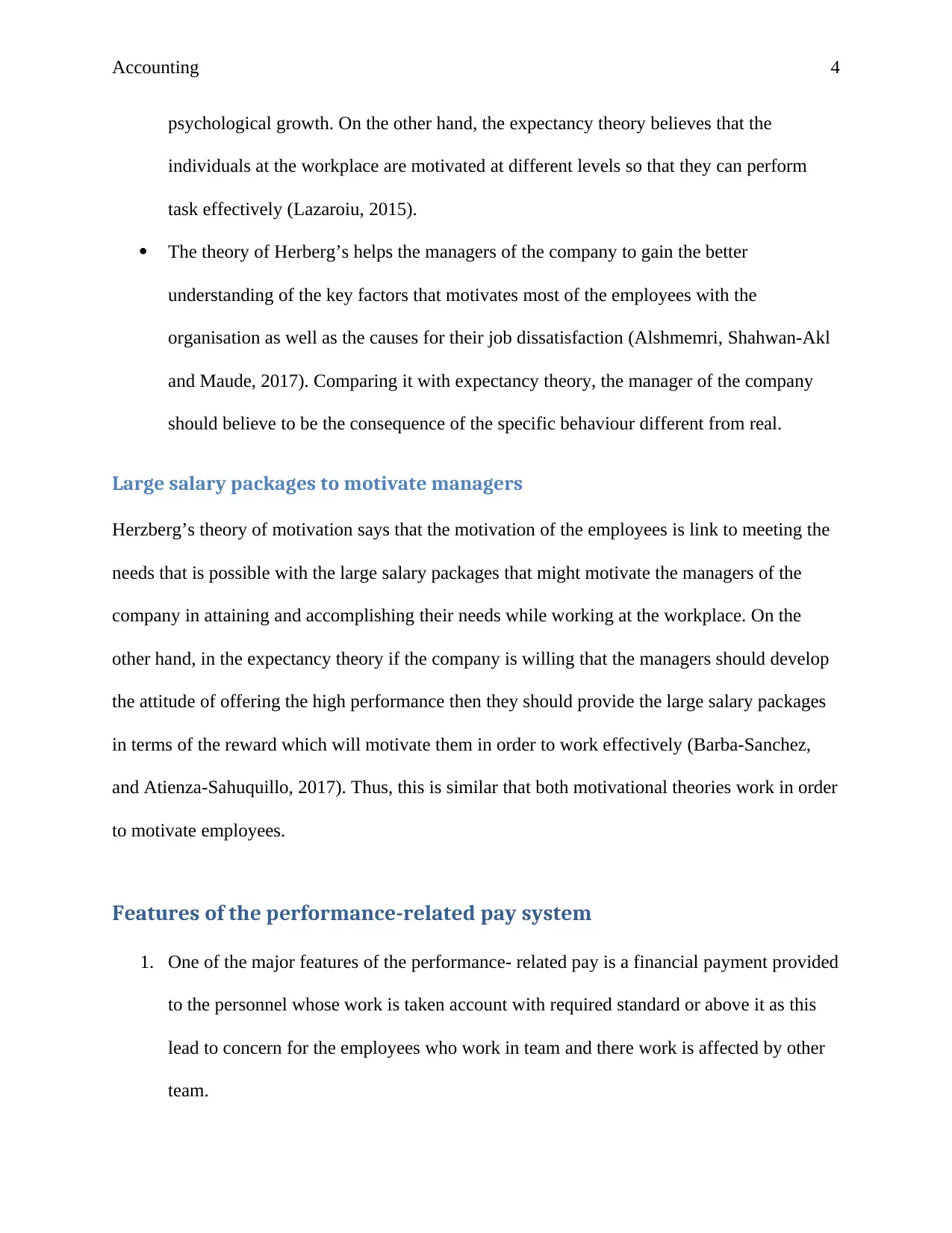
Accounting 4
psychological growth. On the other hand, the expectancy theory believes that the
individuals at the workplace are motivated at different levels so that they can perform
task effectively (Lazaroiu, 2015).
The theory of Herberg’s helps the managers of the company to gain the better
understanding of the key factors that motivates most of the employees with the
organisation as well as the causes for their job dissatisfaction (Alshmemri, Shahwan-Akl
and Maude, 2017). Comparing it with expectancy theory, the manager of the company
should believe to be the consequence of the specific behaviour different from real.
Large salary packages to motivate managers
Herzberg’s theory of motivation says that the motivation of the employees is link to meeting the
needs that is possible with the large salary packages that might motivate the managers of the
company in attaining and accomplishing their needs while working at the workplace. On the
other hand, in the expectancy theory if the company is willing that the managers should develop
the attitude of offering the high performance then they should provide the large salary packages
in terms of the reward which will motivate them in order to work effectively (Barba-Sanchez,
and Atienza-Sahuquillo, 2017). Thus, this is similar that both motivational theories work in order
to motivate employees.
Features of the performance-related pay system
1. One of the major features of the performance- related pay is a financial payment provided
to the personnel whose work is taken account with required standard or above it as this
lead to concern for the employees who work in team and there work is affected by other
team.
psychological growth. On the other hand, the expectancy theory believes that the
individuals at the workplace are motivated at different levels so that they can perform
task effectively (Lazaroiu, 2015).
The theory of Herberg’s helps the managers of the company to gain the better
understanding of the key factors that motivates most of the employees with the
organisation as well as the causes for their job dissatisfaction (Alshmemri, Shahwan-Akl
and Maude, 2017). Comparing it with expectancy theory, the manager of the company
should believe to be the consequence of the specific behaviour different from real.
Large salary packages to motivate managers
Herzberg’s theory of motivation says that the motivation of the employees is link to meeting the
needs that is possible with the large salary packages that might motivate the managers of the
company in attaining and accomplishing their needs while working at the workplace. On the
other hand, in the expectancy theory if the company is willing that the managers should develop
the attitude of offering the high performance then they should provide the large salary packages
in terms of the reward which will motivate them in order to work effectively (Barba-Sanchez,
and Atienza-Sahuquillo, 2017). Thus, this is similar that both motivational theories work in order
to motivate employees.
Features of the performance-related pay system
1. One of the major features of the performance- related pay is a financial payment provided
to the personnel whose work is taken account with required standard or above it as this
lead to concern for the employees who work in team and there work is affected by other
team.
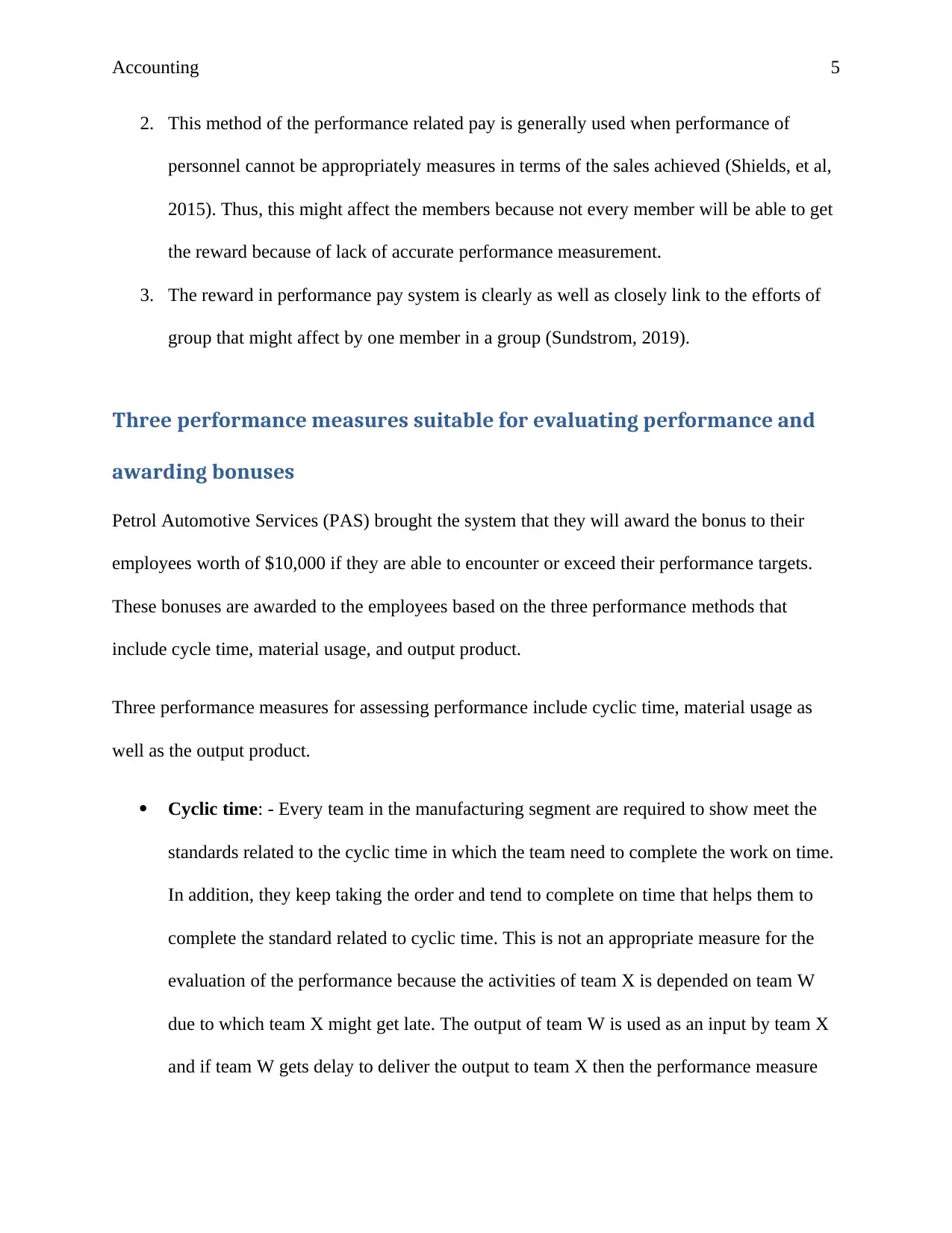
Accounting 5
2. This method of the performance related pay is generally used when performance of
personnel cannot be appropriately measures in terms of the sales achieved (Shields, et al,
2015). Thus, this might affect the members because not every member will be able to get
the reward because of lack of accurate performance measurement.
3. The reward in performance pay system is clearly as well as closely link to the efforts of
group that might affect by one member in a group (Sundstrom, 2019).
Three performance measures suitable for evaluating performance and
awarding bonuses
Petrol Automotive Services (PAS) brought the system that they will award the bonus to their
employees worth of $10,000 if they are able to encounter or exceed their performance targets.
These bonuses are awarded to the employees based on the three performance methods that
include cycle time, material usage, and output product.
Three performance measures for assessing performance include cyclic time, material usage as
well as the output product.
Cyclic time: - Every team in the manufacturing segment are required to show meet the
standards related to the cyclic time in which the team need to complete the work on time.
In addition, they keep taking the order and tend to complete on time that helps them to
complete the standard related to cyclic time. This is not an appropriate measure for the
evaluation of the performance because the activities of team X is depended on team W
due to which team X might get late. The output of team W is used as an input by team X
and if team W gets delay to deliver the output to team X then the performance measure
2. This method of the performance related pay is generally used when performance of
personnel cannot be appropriately measures in terms of the sales achieved (Shields, et al,
2015). Thus, this might affect the members because not every member will be able to get
the reward because of lack of accurate performance measurement.
3. The reward in performance pay system is clearly as well as closely link to the efforts of
group that might affect by one member in a group (Sundstrom, 2019).
Three performance measures suitable for evaluating performance and
awarding bonuses
Petrol Automotive Services (PAS) brought the system that they will award the bonus to their
employees worth of $10,000 if they are able to encounter or exceed their performance targets.
These bonuses are awarded to the employees based on the three performance methods that
include cycle time, material usage, and output product.
Three performance measures for assessing performance include cyclic time, material usage as
well as the output product.
Cyclic time: - Every team in the manufacturing segment are required to show meet the
standards related to the cyclic time in which the team need to complete the work on time.
In addition, they keep taking the order and tend to complete on time that helps them to
complete the standard related to cyclic time. This is not an appropriate measure for the
evaluation of the performance because the activities of team X is depended on team W
due to which team X might get late. The output of team W is used as an input by team X
and if team W gets delay to deliver the output to team X then the performance measure
⊘ This is a preview!⊘
Do you want full access?
Subscribe today to unlock all pages.

Trusted by 1+ million students worldwide
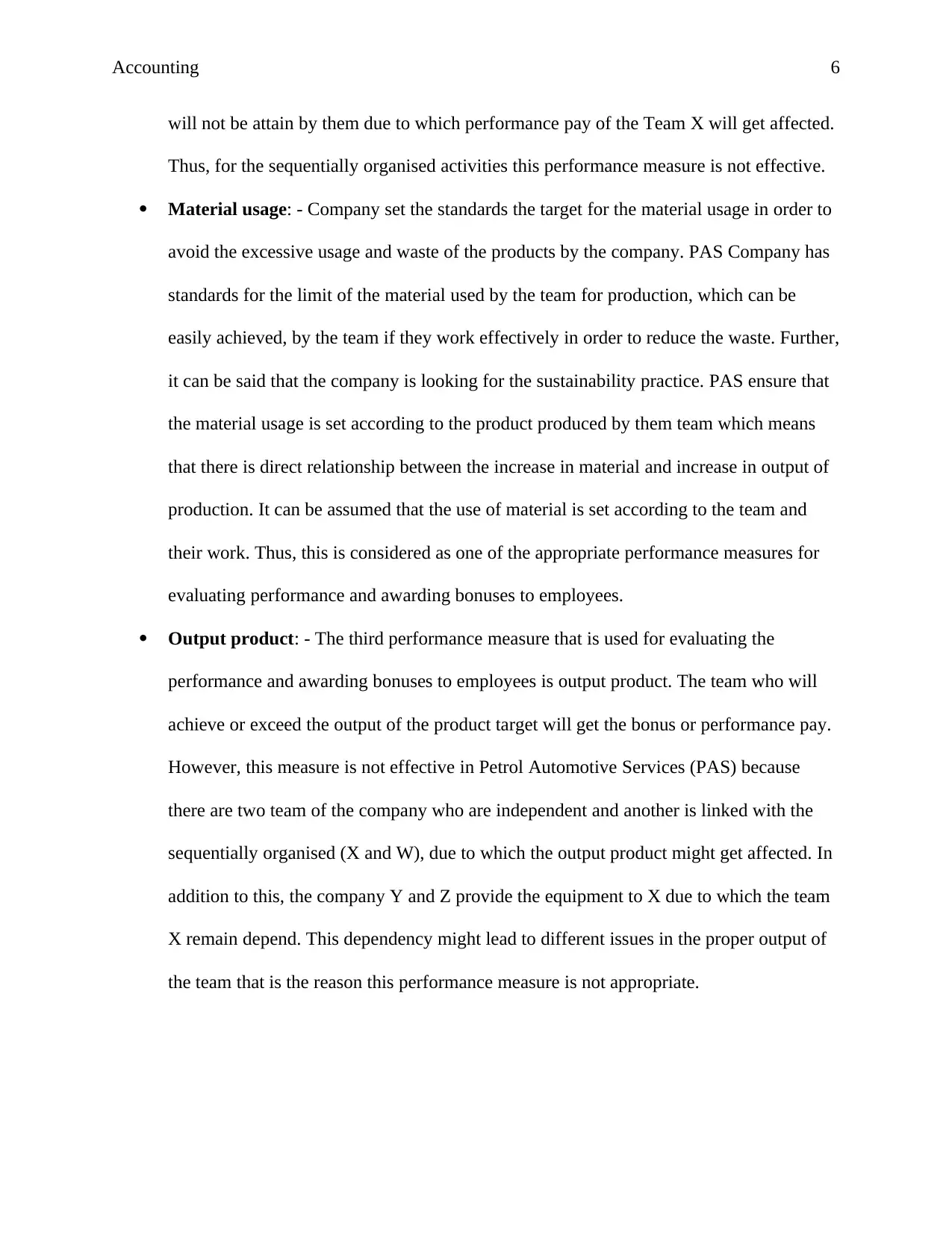
Accounting 6
will not be attain by them due to which performance pay of the Team X will get affected.
Thus, for the sequentially organised activities this performance measure is not effective.
Material usage: - Company set the standards the target for the material usage in order to
avoid the excessive usage and waste of the products by the company. PAS Company has
standards for the limit of the material used by the team for production, which can be
easily achieved, by the team if they work effectively in order to reduce the waste. Further,
it can be said that the company is looking for the sustainability practice. PAS ensure that
the material usage is set according to the product produced by them team which means
that there is direct relationship between the increase in material and increase in output of
production. It can be assumed that the use of material is set according to the team and
their work. Thus, this is considered as one of the appropriate performance measures for
evaluating performance and awarding bonuses to employees.
Output product: - The third performance measure that is used for evaluating the
performance and awarding bonuses to employees is output product. The team who will
achieve or exceed the output of the product target will get the bonus or performance pay.
However, this measure is not effective in Petrol Automotive Services (PAS) because
there are two team of the company who are independent and another is linked with the
sequentially organised (X and W), due to which the output product might get affected. In
addition to this, the company Y and Z provide the equipment to X due to which the team
X remain depend. This dependency might lead to different issues in the proper output of
the team that is the reason this performance measure is not appropriate.
will not be attain by them due to which performance pay of the Team X will get affected.
Thus, for the sequentially organised activities this performance measure is not effective.
Material usage: - Company set the standards the target for the material usage in order to
avoid the excessive usage and waste of the products by the company. PAS Company has
standards for the limit of the material used by the team for production, which can be
easily achieved, by the team if they work effectively in order to reduce the waste. Further,
it can be said that the company is looking for the sustainability practice. PAS ensure that
the material usage is set according to the product produced by them team which means
that there is direct relationship between the increase in material and increase in output of
production. It can be assumed that the use of material is set according to the team and
their work. Thus, this is considered as one of the appropriate performance measures for
evaluating performance and awarding bonuses to employees.
Output product: - The third performance measure that is used for evaluating the
performance and awarding bonuses to employees is output product. The team who will
achieve or exceed the output of the product target will get the bonus or performance pay.
However, this measure is not effective in Petrol Automotive Services (PAS) because
there are two team of the company who are independent and another is linked with the
sequentially organised (X and W), due to which the output product might get affected. In
addition to this, the company Y and Z provide the equipment to X due to which the team
X remain depend. This dependency might lead to different issues in the proper output of
the team that is the reason this performance measure is not appropriate.
Paraphrase This Document
Need a fresh take? Get an instant paraphrase of this document with our AI Paraphraser
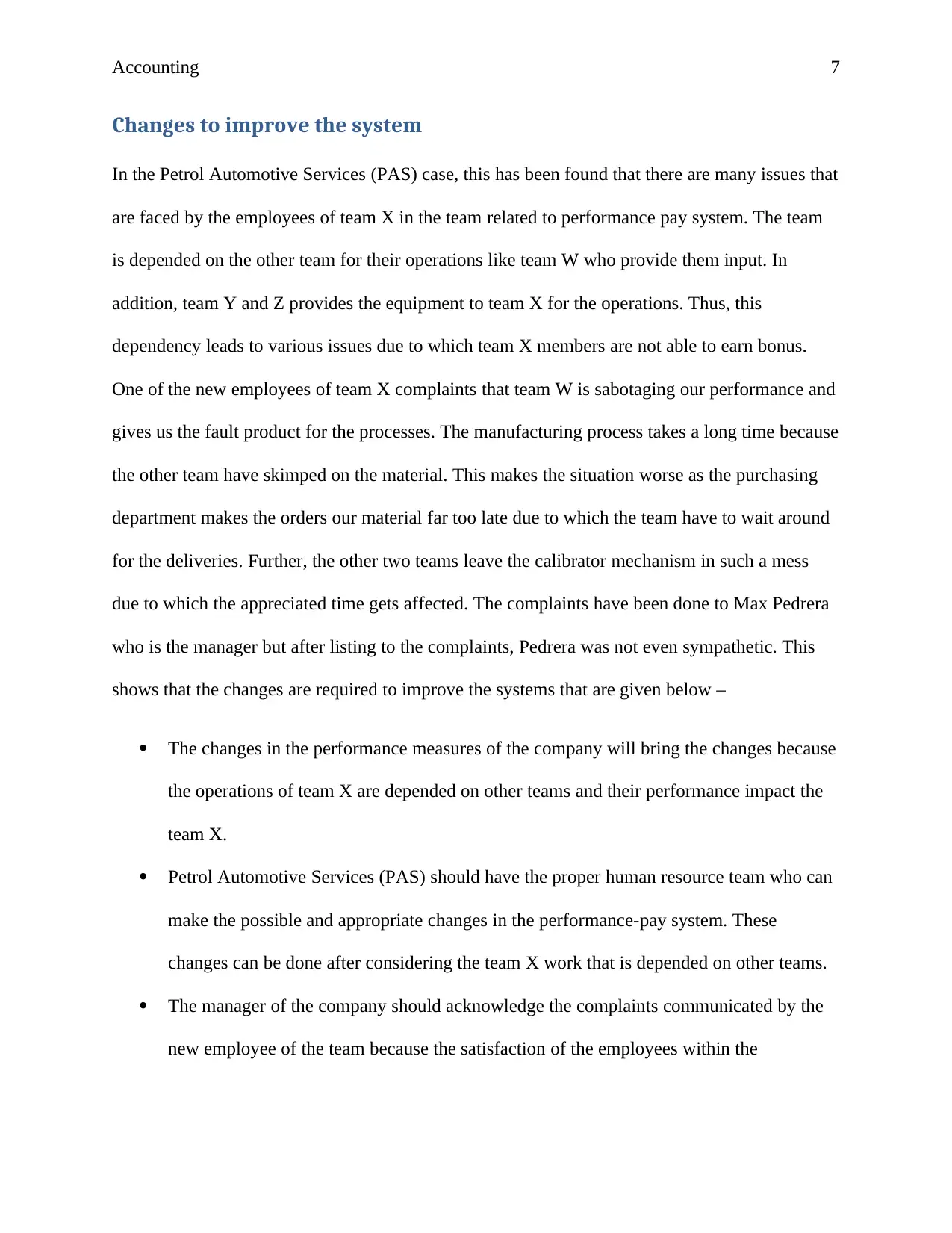
Accounting 7
Changes to improve the system
In the Petrol Automotive Services (PAS) case, this has been found that there are many issues that
are faced by the employees of team X in the team related to performance pay system. The team
is depended on the other team for their operations like team W who provide them input. In
addition, team Y and Z provides the equipment to team X for the operations. Thus, this
dependency leads to various issues due to which team X members are not able to earn bonus.
One of the new employees of team X complaints that team W is sabotaging our performance and
gives us the fault product for the processes. The manufacturing process takes a long time because
the other team have skimped on the material. This makes the situation worse as the purchasing
department makes the orders our material far too late due to which the team have to wait around
for the deliveries. Further, the other two teams leave the calibrator mechanism in such a mess
due to which the appreciated time gets affected. The complaints have been done to Max Pedrera
who is the manager but after listing to the complaints, Pedrera was not even sympathetic. This
shows that the changes are required to improve the systems that are given below –
The changes in the performance measures of the company will bring the changes because
the operations of team X are depended on other teams and their performance impact the
team X.
Petrol Automotive Services (PAS) should have the proper human resource team who can
make the possible and appropriate changes in the performance-pay system. These
changes can be done after considering the team X work that is depended on other teams.
The manager of the company should acknowledge the complaints communicated by the
new employee of the team because the satisfaction of the employees within the
Changes to improve the system
In the Petrol Automotive Services (PAS) case, this has been found that there are many issues that
are faced by the employees of team X in the team related to performance pay system. The team
is depended on the other team for their operations like team W who provide them input. In
addition, team Y and Z provides the equipment to team X for the operations. Thus, this
dependency leads to various issues due to which team X members are not able to earn bonus.
One of the new employees of team X complaints that team W is sabotaging our performance and
gives us the fault product for the processes. The manufacturing process takes a long time because
the other team have skimped on the material. This makes the situation worse as the purchasing
department makes the orders our material far too late due to which the team have to wait around
for the deliveries. Further, the other two teams leave the calibrator mechanism in such a mess
due to which the appreciated time gets affected. The complaints have been done to Max Pedrera
who is the manager but after listing to the complaints, Pedrera was not even sympathetic. This
shows that the changes are required to improve the systems that are given below –
The changes in the performance measures of the company will bring the changes because
the operations of team X are depended on other teams and their performance impact the
team X.
Petrol Automotive Services (PAS) should have the proper human resource team who can
make the possible and appropriate changes in the performance-pay system. These
changes can be done after considering the team X work that is depended on other teams.
The manager of the company should acknowledge the complaints communicated by the
new employee of the team because the satisfaction of the employees within the
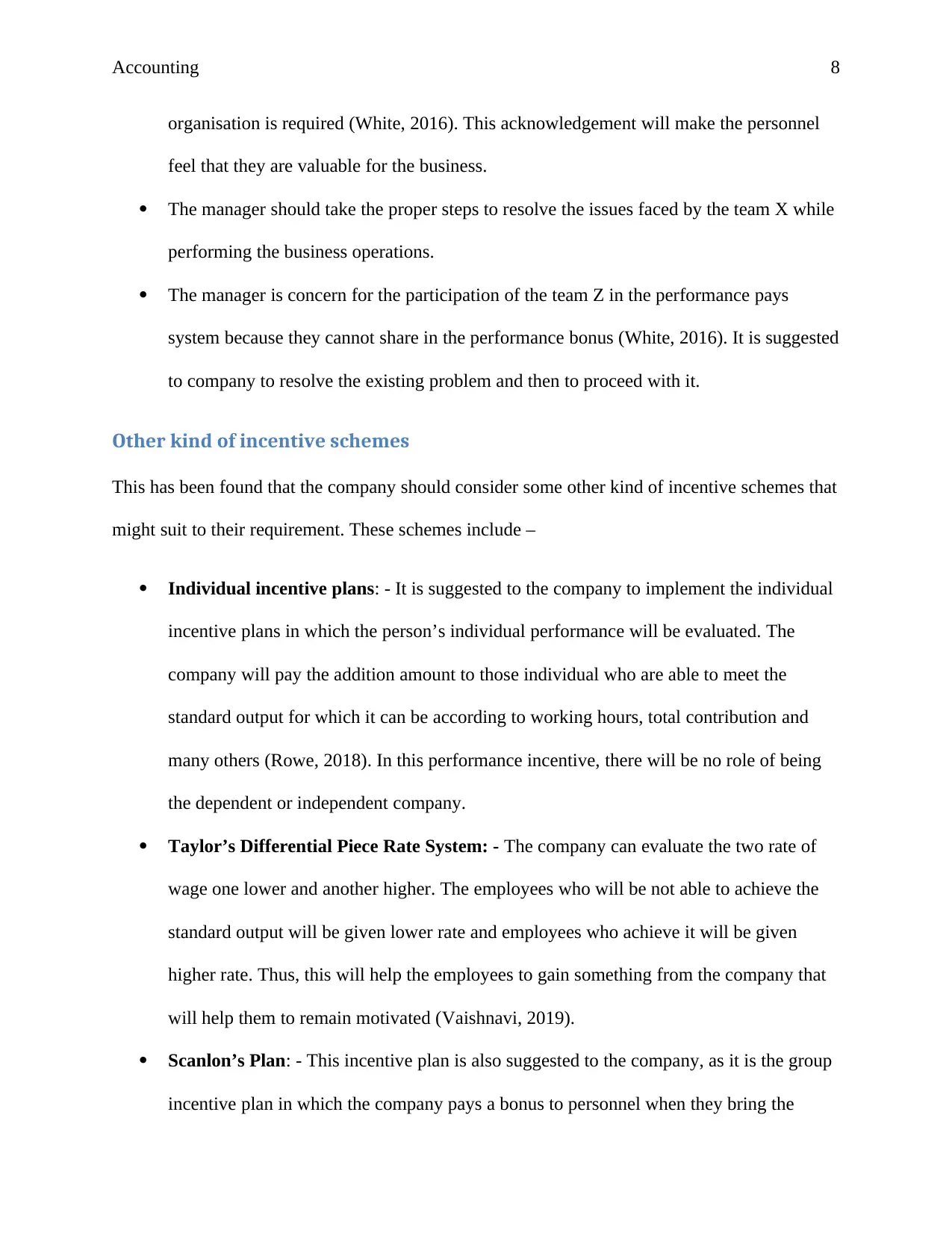
Accounting 8
organisation is required (White, 2016). This acknowledgement will make the personnel
feel that they are valuable for the business.
The manager should take the proper steps to resolve the issues faced by the team X while
performing the business operations.
The manager is concern for the participation of the team Z in the performance pays
system because they cannot share in the performance bonus (White, 2016). It is suggested
to company to resolve the existing problem and then to proceed with it.
Other kind of incentive schemes
This has been found that the company should consider some other kind of incentive schemes that
might suit to their requirement. These schemes include –
Individual incentive plans: - It is suggested to the company to implement the individual
incentive plans in which the person’s individual performance will be evaluated. The
company will pay the addition amount to those individual who are able to meet the
standard output for which it can be according to working hours, total contribution and
many others (Rowe, 2018). In this performance incentive, there will be no role of being
the dependent or independent company.
Taylor’s Differential Piece Rate System: - The company can evaluate the two rate of
wage one lower and another higher. The employees who will be not able to achieve the
standard output will be given lower rate and employees who achieve it will be given
higher rate. Thus, this will help the employees to gain something from the company that
will help them to remain motivated (Vaishnavi, 2019).
Scanlon’s Plan: - This incentive plan is also suggested to the company, as it is the group
incentive plan in which the company pays a bonus to personnel when they bring the
organisation is required (White, 2016). This acknowledgement will make the personnel
feel that they are valuable for the business.
The manager should take the proper steps to resolve the issues faced by the team X while
performing the business operations.
The manager is concern for the participation of the team Z in the performance pays
system because they cannot share in the performance bonus (White, 2016). It is suggested
to company to resolve the existing problem and then to proceed with it.
Other kind of incentive schemes
This has been found that the company should consider some other kind of incentive schemes that
might suit to their requirement. These schemes include –
Individual incentive plans: - It is suggested to the company to implement the individual
incentive plans in which the person’s individual performance will be evaluated. The
company will pay the addition amount to those individual who are able to meet the
standard output for which it can be according to working hours, total contribution and
many others (Rowe, 2018). In this performance incentive, there will be no role of being
the dependent or independent company.
Taylor’s Differential Piece Rate System: - The company can evaluate the two rate of
wage one lower and another higher. The employees who will be not able to achieve the
standard output will be given lower rate and employees who achieve it will be given
higher rate. Thus, this will help the employees to gain something from the company that
will help them to remain motivated (Vaishnavi, 2019).
Scanlon’s Plan: - This incentive plan is also suggested to the company, as it is the group
incentive plan in which the company pays a bonus to personnel when they bring the
⊘ This is a preview!⊘
Do you want full access?
Subscribe today to unlock all pages.

Trusted by 1+ million students worldwide
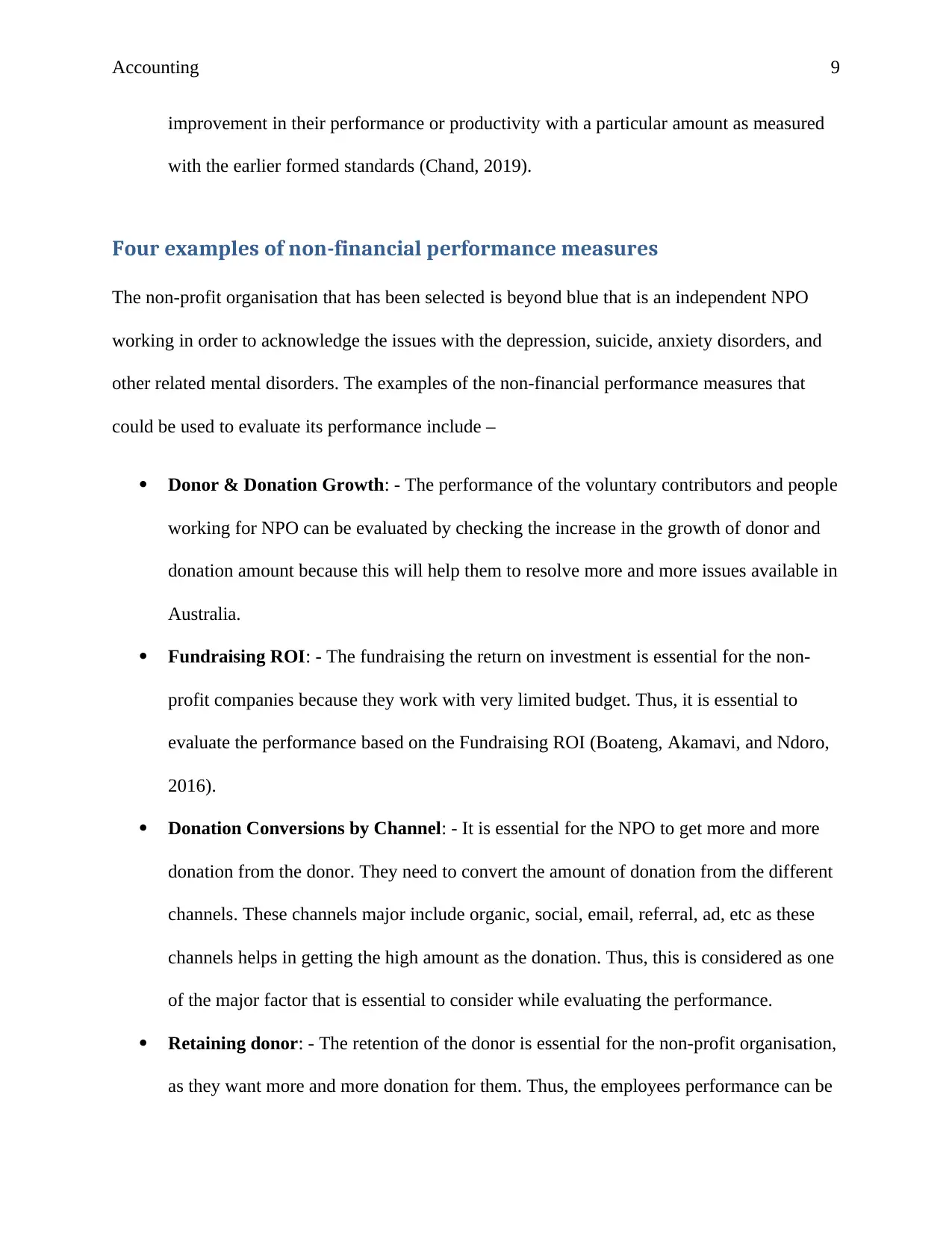
Accounting 9
improvement in their performance or productivity with a particular amount as measured
with the earlier formed standards (Chand, 2019).
Four examples of non-financial performance measures
The non-profit organisation that has been selected is beyond blue that is an independent NPO
working in order to acknowledge the issues with the depression, suicide, anxiety disorders, and
other related mental disorders. The examples of the non-financial performance measures that
could be used to evaluate its performance include –
Donor & Donation Growth: - The performance of the voluntary contributors and people
working for NPO can be evaluated by checking the increase in the growth of donor and
donation amount because this will help them to resolve more and more issues available in
Australia.
Fundraising ROI: - The fundraising the return on investment is essential for the non-
profit companies because they work with very limited budget. Thus, it is essential to
evaluate the performance based on the Fundraising ROI (Boateng, Akamavi, and Ndoro,
2016).
Donation Conversions by Channel: - It is essential for the NPO to get more and more
donation from the donor. They need to convert the amount of donation from the different
channels. These channels major include organic, social, email, referral, ad, etc as these
channels helps in getting the high amount as the donation. Thus, this is considered as one
of the major factor that is essential to consider while evaluating the performance.
Retaining donor: - The retention of the donor is essential for the non-profit organisation,
as they want more and more donation for them. Thus, the employees performance can be
improvement in their performance or productivity with a particular amount as measured
with the earlier formed standards (Chand, 2019).
Four examples of non-financial performance measures
The non-profit organisation that has been selected is beyond blue that is an independent NPO
working in order to acknowledge the issues with the depression, suicide, anxiety disorders, and
other related mental disorders. The examples of the non-financial performance measures that
could be used to evaluate its performance include –
Donor & Donation Growth: - The performance of the voluntary contributors and people
working for NPO can be evaluated by checking the increase in the growth of donor and
donation amount because this will help them to resolve more and more issues available in
Australia.
Fundraising ROI: - The fundraising the return on investment is essential for the non-
profit companies because they work with very limited budget. Thus, it is essential to
evaluate the performance based on the Fundraising ROI (Boateng, Akamavi, and Ndoro,
2016).
Donation Conversions by Channel: - It is essential for the NPO to get more and more
donation from the donor. They need to convert the amount of donation from the different
channels. These channels major include organic, social, email, referral, ad, etc as these
channels helps in getting the high amount as the donation. Thus, this is considered as one
of the major factor that is essential to consider while evaluating the performance.
Retaining donor: - The retention of the donor is essential for the non-profit organisation,
as they want more and more donation for them. Thus, the employees performance can be
Paraphrase This Document
Need a fresh take? Get an instant paraphrase of this document with our AI Paraphraser

Accounting 10
evaluated based on the number of donor retain by them (Polonsky, Landreth Grau and
McDonald, 2016).
evaluated based on the number of donor retain by them (Polonsky, Landreth Grau and
McDonald, 2016).
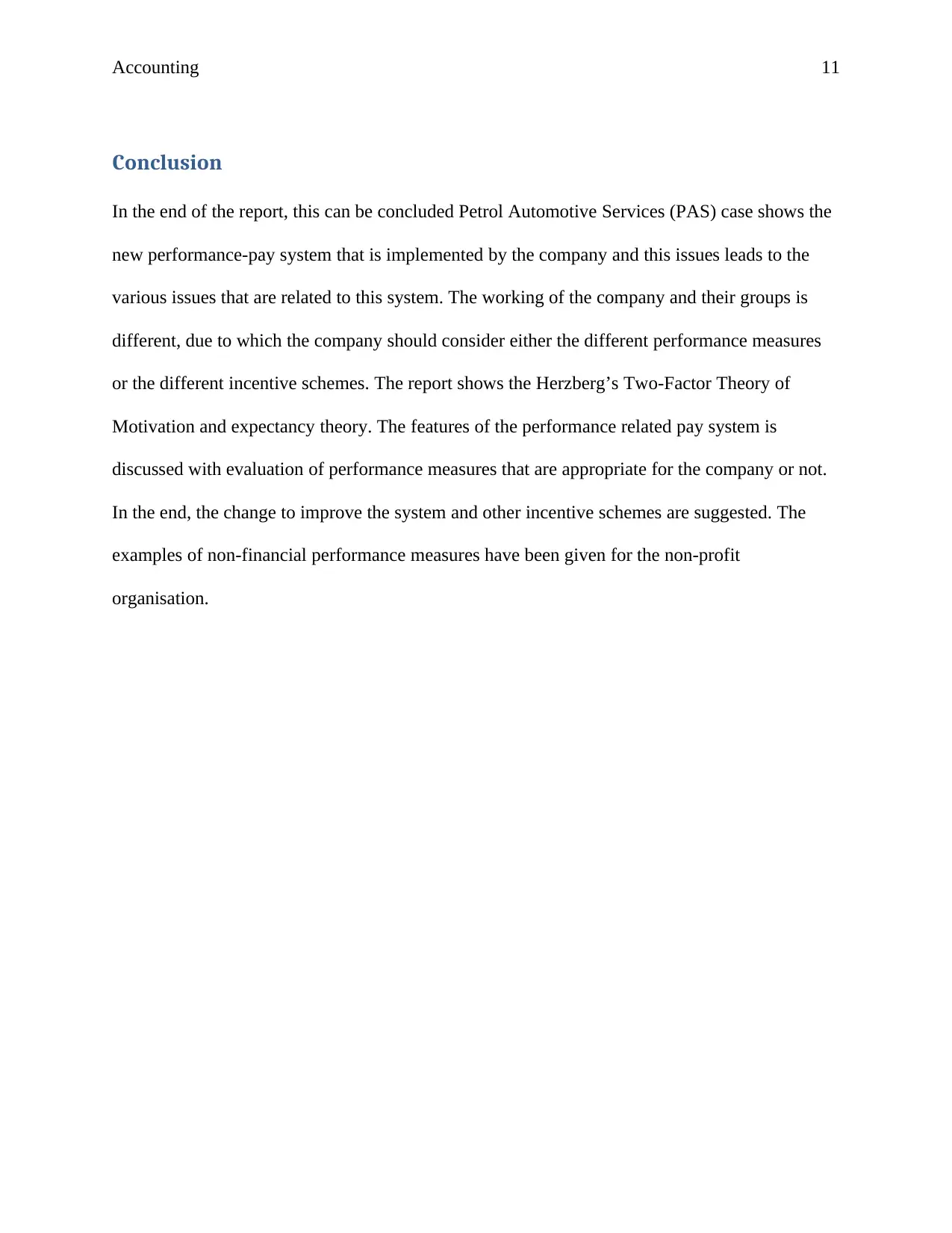
Accounting 11
Conclusion
In the end of the report, this can be concluded Petrol Automotive Services (PAS) case shows the
new performance-pay system that is implemented by the company and this issues leads to the
various issues that are related to this system. The working of the company and their groups is
different, due to which the company should consider either the different performance measures
or the different incentive schemes. The report shows the Herzberg’s Two-Factor Theory of
Motivation and expectancy theory. The features of the performance related pay system is
discussed with evaluation of performance measures that are appropriate for the company or not.
In the end, the change to improve the system and other incentive schemes are suggested. The
examples of non-financial performance measures have been given for the non-profit
organisation.
Conclusion
In the end of the report, this can be concluded Petrol Automotive Services (PAS) case shows the
new performance-pay system that is implemented by the company and this issues leads to the
various issues that are related to this system. The working of the company and their groups is
different, due to which the company should consider either the different performance measures
or the different incentive schemes. The report shows the Herzberg’s Two-Factor Theory of
Motivation and expectancy theory. The features of the performance related pay system is
discussed with evaluation of performance measures that are appropriate for the company or not.
In the end, the change to improve the system and other incentive schemes are suggested. The
examples of non-financial performance measures have been given for the non-profit
organisation.
⊘ This is a preview!⊘
Do you want full access?
Subscribe today to unlock all pages.

Trusted by 1+ million students worldwide
1 out of 14
Related Documents
Your All-in-One AI-Powered Toolkit for Academic Success.
+13062052269
info@desklib.com
Available 24*7 on WhatsApp / Email
![[object Object]](/_next/static/media/star-bottom.7253800d.svg)
Unlock your academic potential
Copyright © 2020–2025 A2Z Services. All Rights Reserved. Developed and managed by ZUCOL.




